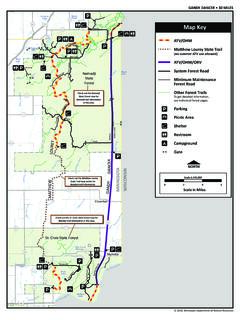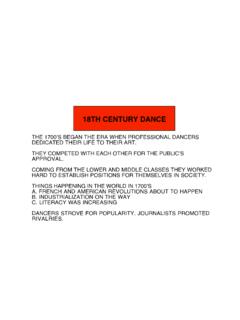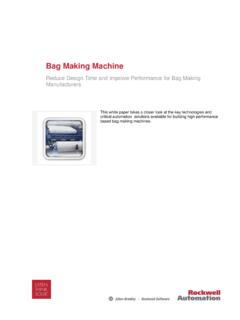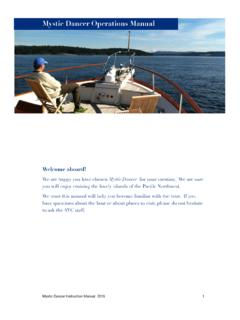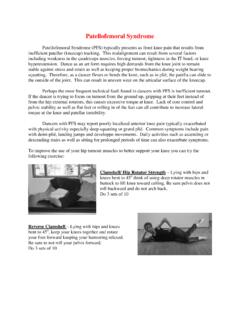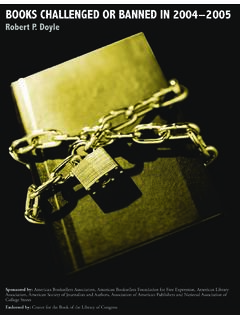Transcription of Screening for Improved Dance Function
1 14 Copyright 2011 International Association for Dance Medicine & Science simple quote represents the deep feelings that many teachers have for their students of Dance a wish, in a sense, that one could Dance forever with ease, minimal problems, and injury free. Freedom to a dancer , as Martha Graham stated, ..means discipline. That is what technique is for liberation. 1 This liberty is the result of motivated pursuit, year after year, aspiring to perform with skill, grace, and efficiency, attributes that may be considered the ultimate in physical expression. Dancers strive to Dance , as Isadora Duncan said, with highest intel-ligence in the freest body 2 for as long as possible. And, it is Dance teachers who play a critical role in their students Dance Medicine, Dance Science, and Dance ScreeningImagine a world where dancers are able to learn specifics about their physical condition similar to what commonly occurs with other athletes.
2 Then imagine that by performing some simple exercises given by the teacher and/or a team of medical professionals cognizant of the unique demands of Dance , the dancer happily reports later that many of her basic Dance skills have Improved and she generally feels better about herself and her dancing. These worlds do ex-ist, and new ones are being created by dedicated teachers and medical professionals in Dance companies, schools, conservatories, and As is the case with modern fact finding, dancers use the internet to get information about various issues related to Dance , health, nutrition, anatomy, and injury preven-tion, and are also learning about the value of wellness and They are also becoming aware of the growing number of medical professionals who are conducting research in Dance medicine and science and are dedicated to helping dancers train more effectively and efficiently and Dance longer.
3 In many countries there is an emerg-ing trend toward preventative medicine in health care systems that involve screenings. The implementation of Dance Screening has immediate and potentially long term benefits for dancers. So what is Dance Screening and why do it? A typical Dance screen is a series of tests designed to assess the overall well-being and functional capacity of dancers. The data collected are used to provide a physical, medical, nutritional, and/or psychological profile for each dancer . The results of a screen can help teachers and other Dance professionals enable dancers to realize their full potential, and may also help detect potentially life-threatening or disabling medical or musculoskeletal conditions that may limit a dancer s safe participation and help to detect medi-cal or musculoskeletal conditions that may predispose dancers to injury and/or illness during their season.
4 7 More importantly, many professionals have suggested that Screening can play a role in enhancing a dancer s ability and may help them change patterns of movement that might result in stronger bodies and better It is very important that screens are NOT used as a test of acceptability into a company or school. Rather, at the very heart of contemporary approaches to Screening is the goal of providing a set of tools to support dynamic interactions between dancer , teachers, and other professionals for the benefit of the Goes Into a Functional Screen?There are many different screens in use by various profes-sional companies and schools. Basic tests and measures can be used to assess and improve Dance Function for teachers, schools and health care professionals who work together as a team but do not have Screening experience.
5 Common components of a screen include orthopedic assessments that examine a dancer s overall structure, strength, flexibility and laxity. Also commonly included are various functional components such as Dance tech-nique or related movement-based assessments intended to help identify areas where a dancer may benefit from refinement exercises or changes in motor patterning that can be done during or outside of the technique class. Tests that examine balance and general cardiovascular fitness are Screening for Improved Dance FunctionKaren Potter, , Case Western University, Ohio, Gary Galbraith, , Case Western University, Ohio, and Jane Baas, , Western Michigan University, Michigan, USA When you do Dance , I wish youA wave o the sea, that you might ever doNothing but that.
6 William Shakespeare15 The IADMS Bulletin for Teachers Volume 3, Number 1, 2011also conducted, given that these are part of most training and performance demands. Components of a Functional ScreenWell designed screens may identify deficiencies which, once corrected, may improve Function . The goals of a screen and many specific factors may influence the type of screen that is appropriate and the number of assessments that can be feasibly included. The Screening team may include physi-cal therapists, athletic trainers or other equally qualified medical professional, Dance teachers, and movement science researchers. In some cases students may be trained to screen as part of an educational Planning for what to do with the data that are collected is very important, and Screening teams should discuss in advance how this information is to be used.
7 Confidentiality of all Screening information is paramount. Therefore, the Screening team should decide in advance who is to have access to what information. Prior to any screen dancers must be fully informed of the following: 1) what is go-ing to happen, 2) what information is being collected, 3) how the information is going to be used, and 4) who will have access to this information. When dancers are minors, this information must be disclosed and agreed upon with the parents or legal guardians of the dancer prior to any screenings. One example of a project that addresses all of these issues and is currently available to assist teachers and professionals in Screening dancers is the dancer Wellness Project (DWP).
8 12 On the web site there are sample screens that can be customized to suit individual Starter Functional ScreenThrough a collaborative effort of experienced wellness professionals, a starter screen was designed to support the needs of those people initiating their respective Screening programs. This screen includes assessments that can be per-formed by Dance educators who have a basic understanding of kinesiology or anatomy, along with assessments that can be performed by a physical therapist, athletic trainer, or equally qualified individual who may not have experience working with dancers. A starter screen could include the tests and measures listed below. These were chosen because attributes or deficien-cies in these areas affect Dance Function and performance.
9 Once the screeners become experienced, they will begin to recognize successful movement patterns or impairments. Additional tests and measures can be added as necessary. I. TECHNIQUE: look for attributes or faulty movement patterning A. Parallel position to first position B. Demi-pli in first position C. Grand pli in first position D. Relev in first position E. Pass balance flat F. D velopp devant, la seconde, derri re G. Single pirouette en dehor H. Port de bras first to fifth and first to second I. Jumps in firstII. FITNESS YMCA 3-minute step testIII. BALANCE TEST 60-second stork test IV. STRUCTURAL A. Anterior 1. Iliac crest alignment 2. Leg length 3. Knee alignment 4. Tibial torsion 5. Morton s short toe B. Lateral 1.
10 Forward head 2. Shoulder alignment 3. Kyphosis/lordosis 4. Pelvic tilt 5. Genu recurvatum C. Posterior 1. Head tilt 2. Shoulders level 3. Scapular winging 4. Scapulohumeral rhythm 5. Adams forward bend test 6. Foot alignment 7. Hallux valgusV. STRENGTH: general movement patterns or synergies A. Serratus anterior B. Trapezius C. Rhomboids D. Quadratus lumborum E. Upper and lower abdominals F. Hip internal/external rotation as well as abduction and adduction G. Gluteus medius and maximus H. Flexor hallucis longus I. Peroneals J. Foot intrinsicsVI. FLEXIBILITY/LAXITY A. Turnout 1. Total turnout 2. Standing - floor and discs B. Beighton score C. Range of motion(ROM) & special tests 1. Cervical spine ROM 2. Trunk spine ROM 3.
